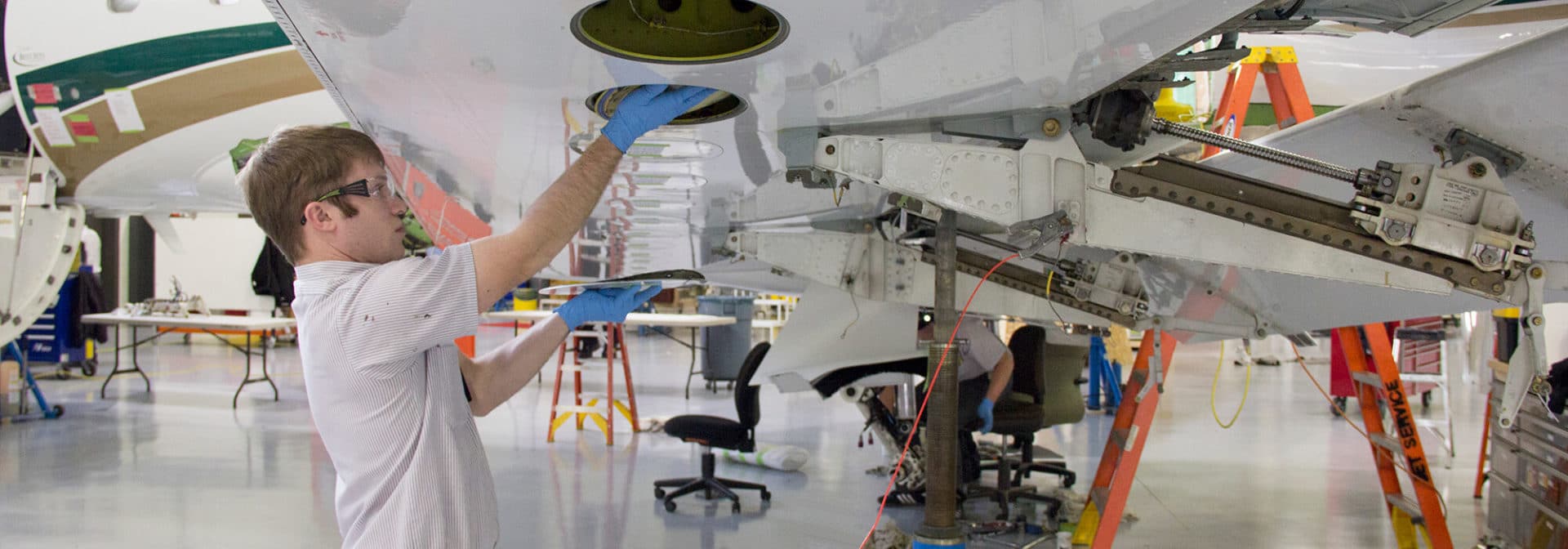Aircraft Pre-Purchase Inspections
During an aircraft purchase, a pre-purchase inspection from a reputable facility is critical to keep all dealings fair between the buyer and seller. Elliott Aviation provides a straightforward approach for all pre-purchase inspections and offers many different options depending on the airframe. Our technicians have completed thousands of pre-purchase aircraft inspections and understand the importance of providing an unbiased, evidence-based approach to keep the transaction moving forward. We provide this service on the following airframes:
- Hawker
- Phenom
- Beechjet 400A/Hawker 400XP
- Citation
- Premier
- Challenger 300
- King Air
STANDARD PRE-PURCHASE SURVEY
Elliott Aviation will comply with the below list of Pre-Purchase Evaluation items per customer request in accordance with maintenance manual directions.
1. DOCUMENT REVIEW / AIRCRAFT RECORDS INVENTORY TO INCLUDE:
- Review airframe and engine logbooks to evaluate compliance with selected maintenance and inspection program. Identify any additional actions needed to comply with operating rules specified by the customer. (Note: An additional charge will apply for aircraft older than five (5) years and/or non-domestic aircraft.)
- Ensure that the aircraft flight manual is compliant with the latest revision standards and includes any required supplements applicable to installed equipment.
- Cross-check of equipment list and aircraft configuration.
- Cross-check of TCDS and aircraft configuration, list of STC´s, and confirm that FAA form 337’s are present for all major repairs or alterations per 14 CFR Part 43.9 and appendix B.
- Identify any record that speaks to major modifications, major damage, major repair, or major alteration.
- Check onboard aircraft registration documents.
- Check scheduled maintenance due within 90 days or 100 aircraft hours.
- Check AC SB and AD status (sample inspection based on SB/SL/AD status provided by owner/operator).
- Check for time/cycle life-limited components and overdue items.
- Check aircraft weight and balance records and report the date of last weight and balance.
2. AIRFRAME REVIEW /DETAILED AIRFRAME WALK AROUND IN ACCORDANCE WITH AIRCRAFT FLIGHT MANUAL IN ACCORDANCE WITH BELOW LIST:
- Perform a visual inspection of the fuselage exterior for signs of corrosion, lightning strike, hail damage, evidence of loose fasteners, and missing paint. No panels are removed for this inspection.
- Perform an external visual inspection of wings, ailerons, and flaps for signs of corrosion, lightning strike, evidence of loose fasteners, and missing paint (including visible flight control cables). No panels are removed for this inspection.
- Remove wheels and visually inspect landing gear, brakes, axles, bearings, wheel assemblies for wear, corrosion, and leakage. Record brake and tire wear and tire pressures, calculate remaining brake life.
- Perform an external visual inspection of stabilizers, elevators, and rudder for signs of corrosion, lightning strike, hail damage, evidence of loose fasteners, and missing paint (including visual inspection of de-icing boots).
- Check cockpit windshields and side windows for scratches, delamination, and prism check (as applicable). Check cabin windows for delamination, distortion, scratches, and general condition.
- Perform ultrasonic thickness inspection of cockpit and cabin windows.
- Check exterior placards and marking for installation and readability.
3. FUNCTIONAL CHECK OF AIRFRAME SYSTEMS AS STATED BELOW:
- Perform fuel storage leak check and classification per Aircraft Maintenance Manual.
- Perform interior and exterior lights functional check.
4. AVIONIC AND ELECTRIC SYSTEMS CHECKS AS STATED BELOW:
- Perform a visual inspection of all antennas for erosion, cracks, cracked/missing sealant, and corroded fasteners.
- Perform a visual inspection of static wicks and radome diverter strips per Aircraft Maintenance Manual.
5. INTERIOR REVIEW/EQUIPMENT INVENTORY AS STATED BELOW:
- Perform a check of the aircraft’s loose equipment inventory and issue an inventory list.
- Check all crew and passenger seats for condition and function.
- Perform lavatory corrosion inspection (blue water check).
- Check interior placards and marking for installation and readability.
- Perform visual and functional inspection of the interior (e.g. paint chipping or cracks in woodwork, executive table functional check, galley and lavatory doors functional check as applicable).
6. ENGINES AS STATED BELOW:
- Perform “Engine FOD Inspection,” limited to a visual examination. Additional potential discrepancies observed during the inspection in areas(s) beyond the identified areas will also be reported. (If the engine is on an engine program or under warranty, authorization will be requested).
Repair of discrepancies found during the evaluation may result in additional downtime and expense of parts or labor charges. You will be consulted prior to beginning any additional work.



